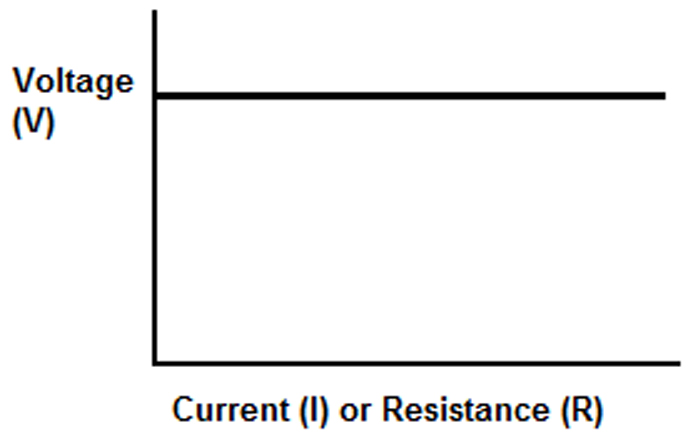What is Constant Voltage?
A constant voltage driver is designed to maintain a constant voltage level during operation regardless of current variations. For example Sunpower’s RS-25-5 can provide 5V/0~5A, the output voltage remains constant at 5V whilst the output current varies from 0~5A based on the load condition. Should the constant voltage power supply exceed 5A (The rated current) then the power supply will go into an overload protection mode (operating from 105~150% of the rated output power).
The constant voltage source provides a constant voltage to the load regardless of variations or changes in the load resistance. For this to happen, the source must have an internal resistance which is very low compared to the resistance of the load it is powering.
Figure 1: Ideal constant voltage behavior
Some of the characteristics of an ideal constant voltage source are:
- Zero internal resistance
- Maintaining the same voltage regardless of variation in the amount of current drawn by load,
- No current flows when the circuit is not loaded (open circuited).
How a constant voltage source works
For a voltage source to provide a constant voltage, it must have a very low internal resistance, preferably zero – even though this might not be practically possible. When the resistance is very low and using the voltage divider rule, most of the voltage will be dropped across the load, which has a higher resistance. When the internal resistance is much lower compared to the load resistance, such that it can be ignored, the power source output approaches the ideal constant voltage.
Figure 2 Ideal voltage source with zero impedance Image
In an ideal voltage source, the resistance should be zero and all the voltage is dropped across the load resistance. However, an ideal voltage source is usually practically impossible, and a typical voltage source will still have some form of internal resistance.
Constant voltage Sources
The common constant voltage sources are the batteries and regulated power supplies. However, batteries cannot supply the constant voltage for a long time and must be recharged or replaced once exhausted. Further, a circuit may require other voltage levels different from what the batteries provide. In such a case, a voltage conversion circuit and a regulator are used to condition the voltage.
There are various ways of getting a constant voltage in power supplies or when the input voltage is higher than the output. Some of the methods of obtaining the constant voltage include using a voltage divider, series transistor, Zener diode or a combination of Zener diode and switching device such as a transistor or thryristor. In addition, a voltage regulator IC may be used to provide a more stable output better than the discrete components. The SMPSs are used to provide more stable and efficient constant voltages. Compared to the linear regulators, the SMPSs is the best, but are more expensive.
A constant voltage is usually used on circuits that require a steady voltage supply for their efficient operation. For example, the constant voltage drivers are used for paralleled LED strip lighting due to the circuit design, which produces the most balanced current over the independent output channels.

